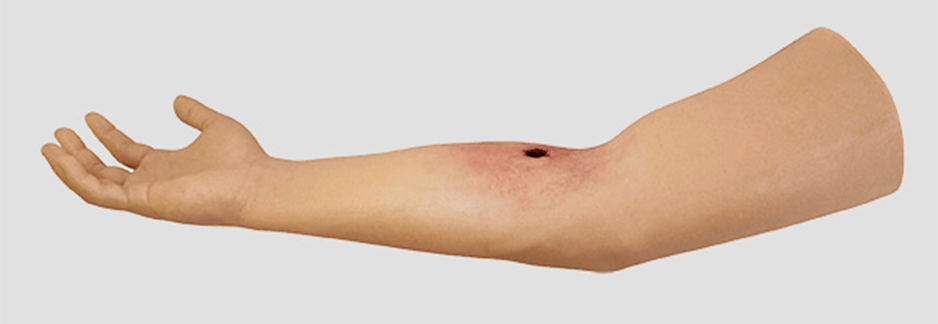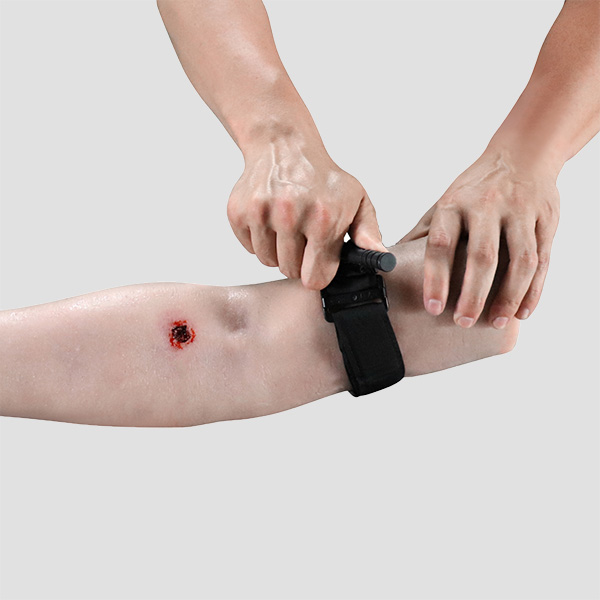While examining an unconscious coworker, you notice they look as if they have two black eyes, and bruising behind the ears. Is this a life-threat?
Absolutely, these are signs of a base of skull fracture. This is a serious life threat.
What type of fires are Type C extinguishers rated for use on.
Electrical.
What is the very first thing you should make sure of, when responding to an ill or injured person?
Your own personal safety and protection.
No smoking or open flames within ____ft of flammable material storage areas?
50'
The proper rate of chest compressions is ____ bpm.
100-120pbm
Employee is struck by a piece of pipe as the excavator flies it into place. A few minutes later, they claim that they are fine, joking that they're 'just gonna have a gnarly bruise', as they lift their shirt to reveal the bruise. Is this a life threat?

Yes, this much darkening, so quickly after the injury, is an indication of internal abdominal bleeding. Call for help immediately.
What type of suppressive agent is typically used in ABC extinguishers.
Dry Powder
What are the ABC's of First Aid?
Airway
Breathing
Circulation
A coworker recieves a burn to the back of their hand, from the muffler on the generator. When you ask to see it, they remove the cluster of ice they are using to cool it, revealing a blistered burn approximately 2" in diameter. What is the wrong here?
Ice or ice water should not be applied to burns.
The proper ratio of chest compressions to rescue breaths is ____:____.
30:2
During the morning safety huddle, the supervisor hands the tablet to an employee to sign in. They begin to reach for the tablet with their right hand, but switch to their left when it seems difficult to lift their right arm. The supervisor makes a joke about this, causing the employee to laugh, but only the left side of their mouth curves up into a smile. What might be the issue?
Potential Stroke - FAST
Face drooping
Arm weakness
Speech difficulties
Time to call
What is the P.A.S.S. Method?
Pull the pin.
Aim at the base of the fire.
Squeeze the lever.
Sweep side-to-side.
Bleeding is not controlled with dressing and pressure, where on the arm do you place the tourniquet? 

Heath is cooking lunch at the jobsite today. An very kind older employee, who absolutely loves his cooking, has helped himself to 3 heaping bowls of Heath's famous chicken and rice bog, then chugs a couple bottles of water to wash it down. A short time later, the man is asleep during a safety talk, so you nudge him. Upon waking, he slurs his words as he begins to yell at you and act aggressively for being woken up. You smell some kind of juice or wine smell on his breath as he screams at you. What is likely the problem here?
The fatigue, altered mental status, irritability, and and fruity smell on the breathe are all signs of a potential Diabetic Emergency.
When providing rescue breaths, you adjust the head to open the airway, pinch the nose closed, and blow air into the victims mouth until ______. (Volume of air blown into victim.)
Until there is a visible rise of the chest.
You're called over to the excavator by a panicked laborer, to find the operator lying on the ground. The laborer states that the operator had been performing their pre-op inspection when they fell from atop the machine. The scene is safe and you have donned proper BSI. As you approach, you can hear snoring respirations from the operator. What is the first intervention that you administer to the excavator operator?
Open the airway using the Jaw Thrust maneuver, due to risk of spinal injury, as it minimizes neck movement.
What kind of burning materials are ABC extinguishers not rated for.
Metals - Type D
&
Cooking Oils and Fats - Type K
A coworker is biten by a snake that is believed to be venomous. When you arrive, other employees have already cleaned and bandaged the bite, and are helping the injured employee to lay on their back in the rear seat of the supervisor's truck, for transport to the ER. What's wrong here?
You should not clean or banage the bite site, move the victim, or lay the victim on their back.
A new employee that started earlier in the week is complaining of a headache and dizziness. Although it's hot, they don't seem to be sweating like everyone else. You ask when they last drank water, but they can't seem to remember. Other employees claim to have witnessed him drinking water 15 minutes prior, and multiple times throughout the day. What action do you take?
Move to a cooler area, loosen or remove clothing, lightly wet exposed skin, allow victim to sip cool water only, and apply ice packs to underarms, groin, and back of neck. Monitor victim closely and call 911 if condition worsens.
The AED attached to a victim has analyzed and states:
"No shock advised."
What o you do next?
Continue chest compressions.
Another employee claims to need a new hardhat, asking you if you'll have the Safety Man bring a new one, while showing you the crack in theirs. You ask how they managed to break it, but they can't seem to remember. After a long pause, they state that they think it might have came that way. They tell you that they're going to go lay down in their car until the new one arrives, and turn to walk away. They hold their hand over their brow to block the sunlight, as they struggle to walk a few steps toward the parking lot, before stopping to vomit. What type of injury/illness do you suspect, and what actions do you take?
Concussion can include confusion, headache, fatigue, dizziness, vomiting, blurred or double vision and sensitivity to light or noise. Changes in behavior, confusion or delayed responses to questioning, fatigue or weakness of limbs and non-equal pupils may indicate a life threat.
Lay the employee down, call for immediate help, and keep them awake.
Describe all points of a fire extinguisher inspection, and what defects would justify removal from service.
Body - damage, rust
Labels - legible and in service range
Guage - fully charged/not discharged/in green
Pull Pin - in place with tamper seal intact
Hose and nozzle - no defects
An acetylene cylinder stored in the shop without a valve cap was knocked over, causing the cylinder to become a projectile, shooting through the shop. Multiple people were injured.
The first victim you assess is a 62-year-old male with bleeding from a compound fracture of the left arm.
During the initial triage, he is responsive but cannot follow commands, pulse is palpable in the uninjured wrist but not in the injured wrist, and respirations are 27 breaths per minute. You tourniquet the arm, tag the victim and move to the next.
During a secondary triage, victim is unresponsive, his radial pulse is no longer palpable in any extremity, but you think you can feel a weak pulse in his neck (carotid), and after repositioning his head, you observe agonal breathing (gasping) at 13 breaths per minute.
How do you tag him during initial triage, and do you change his tag based on the secondary triage?
Initial = RED: The altered mental status (responsive but unable to follow commands) indicates a critical condition requiring immediate attention, possibly due to shock, head injury, or blood loss from the compound fracture.
Secondary = BLACK: Radial pulse not found, agonal breathing is a reflex characterized by gasping or labored breathing that can occur after the heart has stopped, or in the moments leading up to death. The victim is expectant, if not dead already. Unless resources are abundant, a red tag would detract from treating others with better prognoses.
An employee is adjusting a pipe saw on top of a sewer box with a screwdriver. Suddenly, they fall to the ground and begin seizing. You notice the employee is still clutching the screwdriver in their right hand. Their jerking movements are causing the screwdriver to jab into their left forearm and their head to hit the sewer structure. What actions do you take?
Gently remove the screwdriver from their hand if possible and safe to do so, or pad the screwdriver and the head, to prevent them from harming themselves.
You've donned the proper BSI and the scene is safe. You're assessing an unconcious victim when you observe shallow breathing and can feel a very slight, but fast and irratic pulse. What are your next three steps?
Call for help
Get an AED on the way
Begin chest compressions